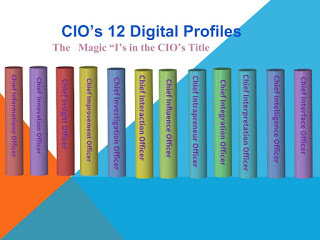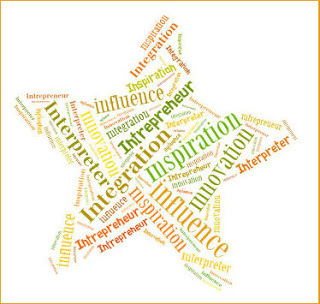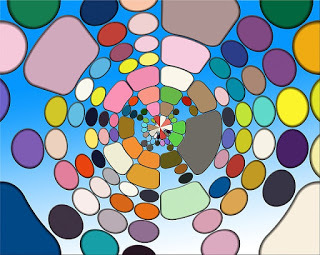Pearl Zhu's Blog, page 1353
March 27, 2016
IT Agility Sum Up: Agile Principles I
 Agility within and of itself is a strategy. Agility is not only the ability to create the change, but also the capability to adapt to the changes. Within an IT, organizational agility should be defined as the speed in which the organization can enable the enterprise's goals and objectives as IT strategy is an integral element of business strategy. Agile is a culture as well!It is important to recognize that moving to Agile may require a significant culture change that affects the entire business. It certainly is NOT just a "development thing.”
Agility within and of itself is a strategy. Agility is not only the ability to create the change, but also the capability to adapt to the changes. Within an IT, organizational agility should be defined as the speed in which the organization can enable the enterprise's goals and objectives as IT strategy is an integral element of business strategy. Agile is a culture as well!It is important to recognize that moving to Agile may require a significant culture change that affects the entire business. It certainly is NOT just a "development thing.”
The Principles to Achieve IT AgilityWhat is the Hardest Agile Principle to Follow - Upon well-known twelve Agile principles, some say, the hardest one for most people to get over is “individuals and interactions over processes and tools”. People are creative beings. What is the process? A process is a perception that the logic steps being identified as of now will help create the product better; keeping in view of the facts that people learned and the related tools they have at hand. So are people always over process or doesn't process bring the order from chaos?
Is Agile a set of Principles or Practices? Agile originally started out as a revolution against rigid, dogmatic practices, but the ironic is that the way some people practice Agile has come full circle back to that rigid adherence to the mechanics of how practices are implemented and have lost sight of the original intent of Agile. So here is an interesting debate: Is agile a set of principles or practices?
The Agile “Simplicity Principle” - How to Dig it Through : “Agile principle -Simplicity--the art of maximizing the amount of work not done” is essential for Agile project success. Simplicity is also a general principle to run the digital business today. Contextually, how do you define and apply it to run project and business more successfully?
Agile Principle Digging Through: Why is it Important to Build a Self-Organizing Team: Creating a self-organizing team is one of the hardest challenges in Agile - or rather the challenge lies in transitioning a team from its current behaviors towards one that is self-organizing. “The best architectures, requirements, and designs emerge from self-organizing teams.” Why is this Agile principle important in practice, how is self-organization related to the best architecture and structure? And how shall you apply these Agile principles to running a digital organization?
 Agile Principle Digging Through: Is Document still Valuable? One of the important points in Agile Manifesto is "Working software over comprehensive documentation". So according to this, the product is given more priority than documentation, but do we still need documents? By stating explicitly that we value the working software rather than the documentation, we will now question whether the documentation is valuable.
Agile Principle Digging Through: Is Document still Valuable? One of the important points in Agile Manifesto is "Working software over comprehensive documentation". So according to this, the product is given more priority than documentation, but do we still need documents? By stating explicitly that we value the working software rather than the documentation, we will now question whether the documentation is valuable.The “Future of CIO” Blog has reached 1.3 million page views with about 2600+ blog posting in 59+ different categories of leadership, management, strategy, digitalization, change/talent, etc. The content richness is not for its own sake, but to convey the vision and share the wisdom. Blogging is not about writing, but about thinking; it’s not just about WHAT to say, but about WHY to say, and HOW to say it. It reflects the color and shade of your thought patterns, and it indicates the peaks and curves of your thinking waves. Unlike pure entertainment, quality and professional content takes time for digesting, contemplation and engaging, and therefore, it takes the time to attract the "hungry minds" and the "deep souls." It’s the journey to amplify your voice, deepen your digital footprints, and match your way for human progression.Follow us at: @Pearl_Zhu
Published on March 27, 2016 22:57
“CIO Master” Book Preview: Chapter 1 “Twelve Digital CIO Personas” Introduction
 Nowadays, information is lifeblood, and technology is the disruptive force in any business and any industry. Hence, CIOs as IT leaders also a play a more critical role in business strategy making & execution, driving business changes and innovation. Compared to other CxOx, the CIO role is considerably new with less than three decades of history, but more dynamic and paradoxical. The IT leadership role also continues to be reimagined, refined, refreshed, and reenergized. The CIO is no longer just a glorified geek, but a business savvy strategist and transformational leader. Modern CIOs have multiple personas and need to wear many hats to communicate effectively and lead more successfully. In chapter 1 of “CIO Master - Unleash the Digital Potential of IT,” we describe CIOs’ 12 Digital profiles. Here we list five featured CIO personas:
Nowadays, information is lifeblood, and technology is the disruptive force in any business and any industry. Hence, CIOs as IT leaders also a play a more critical role in business strategy making & execution, driving business changes and innovation. Compared to other CxOx, the CIO role is considerably new with less than three decades of history, but more dynamic and paradoxical. The IT leadership role also continues to be reimagined, refined, refreshed, and reenergized. The CIO is no longer just a glorified geek, but a business savvy strategist and transformational leader. Modern CIOs have multiple personas and need to wear many hats to communicate effectively and lead more successfully. In chapter 1 of “CIO Master - Unleash the Digital Potential of IT,” we describe CIOs’ 12 Digital profiles. Here we list five featured CIO personas:
CIO as “Chief Information Officer”: Back to fundamental, IT is the information steward of the organization, and the magic “I” in CIO title implies “INFORMATION” - one of the invaluable assets in businesses today. And one of the critical responsibility for IT is to ensure the right people getting the right information at the right time to make right decisions. Because today IT is permeating into every corner of the organization, and all forward-thinking organizations across industrial sectors declare they are into the information management business. IT indeed needs to shift from “T” driven operation to “I” focused - Information, Intelligence, and Insight. And the CIO role needs to focus on both information content and context, how that information can be tapped from the underlying data and be utilized to turn it into valuable business insight and foresight. As CIOs continue to be put on the front line to run IT as a digital transformer, they need to ensure their organizations are information savvy, high-intelligent and high-effective.
CIO as “Chief Innovation Officer”: IT is shifting from a back office function to a digital brain yard; from a support desk to an innovation engine. IT leaders are often in the right position to oversee business processes, identify critical business issues by working closely with business partners from a long-term perspective, and leverage technology to manage innovation across the enterprise boundary. So the challenge for CIOs is how to strike the right balance of innovation and stabilities; flexibility and standardization; long-term perspective and short term quick win. IT leaders also need to manage a balanced innovation portfolio, including both incremental innovation and disruptive innovation, in a systematic way. It also means to build a culture of innovation to tolerate failure and inspire creativity. Opening up a spirit and opportunity for people to stretch and try new things will generate more returns than was ever thought possible.
3. CIO as “Chief Influence Officer”: Digital CIO is a transformational leadership role, not just a transactional manager. Hence, CIOs need to continually practice leadership influence. At the dawn of digitalization, organizations large and small are experiencing social computing, the CIO usually takes the lead role in orchestrating enterprise’s social strategy, sets up the social platforms and tools and governs & monitors their performance. A CIO also must ensure understanding of the business need, a CIO needs to make sure she/he is able to translate the technical needs into the business language. It is also important to add social collaboration theme in IT management. “Eat your own cookie” is part of a CIO’s strategy to give everybody in the organization the user experience. IT leaders can leverage many emerging digital technology trends to amplify leadership influence and scale up innovation practices.
4. CIO as “Chief Intrapreneur Officer”: “Running IT as a software startup” becomes a mantra for many innovative IT organizations. Intrapreneur executive leadership is an emergent trend. It is the mindset and act of behaving like an entrepreneur while working within a large, well-established organization. Often, the CIOs who have come up from a technical ladder are good at bottom line efficiency, but an intrapreneur mindset will help CIOs become more innovative and aggressive, management both opportunities and risks accordingly. It takes courage to be an intrapreneur, as well as a CIO, because it’s not an easy job to face and manage risks and ambiguity, and overcome barriers every day. Many intrapreneurs taste risk as bitter experience and show resilience to recover. Such mental toughness will help any organization to be more resilient and nurture the culture of risk-tolerance and intelligence.

5. CIO as “Chief Interpretation Officer”: Digital IT organizations are not longer the sum of silo functions, but an integral whole. IT leaders are in the unique position to oversight organizational underlying processes, and IT is a key business enabler. Hence. It takes vision-based communication for the CIO to deliver a convincing alternative view of IT being a profit center and value enhancer. The CIO needs to play as a “Chief Interpretation Officer” to convey the vision, to bridge the gaps and to enforce the need for multi-layer, multi-dimensional communication. The CIO needs to be an enterprise “polyglot,’ to master both business language and IT terminology, architectural dialects and culture tones, regional viewpoints and global perspective. A good communication takes empathy as well, the CIO is in the unique position to not only ensure he/she communicates with empathy but also to streamline the organization’s digital communication channel and delivery. And CIOs need to interpret business insight and play different roles effortlessly as a change agent, a strategist, a talent master and a tactical IT manager.
Digital CIOs are born to change, regardless which role they should play in which circumstances, they have to overcome digital transformation challenges depending on their ability to think, adapt, proactively plan and execute. To sum up, the CIO should stand for “Chief Inspirational Officer,” to inspire others to reach business vision and achieve a high-performance result. Follow us at: @Pearl_Zhu
Published on March 27, 2016 22:51
March 26, 2016
The CIO’s Digital Agenda #53: IT Talent Management Innovation (V)
 People are always the most invaluable asset in businesses. “Hiring the right person for the right position at the right time,” is the mantra of many forward-thinking organizations. The question is how would you define the right people? How do you define wrong, average, mediocre, good, great or extraordinary person? Or put simply, for what should they be right? From IT talent management perspective, are those skill gaps real, and how to close the gaps?
People are always the most invaluable asset in businesses. “Hiring the right person for the right position at the right time,” is the mantra of many forward-thinking organizations. The question is how would you define the right people? How do you define wrong, average, mediocre, good, great or extraordinary person? Or put simply, for what should they be right? From IT talent management perspective, are those skill gaps real, and how to close the gaps?
IT Talent Management Innovation (V)CIOs as Talent Masters People are always the most invaluable asset in any organization, and having the right person in the right position at the right time is always one of the biggest challenges facing any business anywhere. This is particularly true for IT, due to the changing nature & complexity of technology and the abundance of information. Is IT skills gap fact or fiction? What differentiates high performance or high potential talented IT professionals from others? And how to manage IT talent, culture, and performance in a more cohesive way?
Three Characteristics of Digital Workforce Digital organizations are always on, interdependent and hyperconnected, people are always the most important asset in any organization before, today, and future. However, compared to a traditional industrial workforce, the digital workforce is a new breed -it's the super Connected generation with a multitude of varieties - multi-generations, multi-cultures, and multi-devices. More specifically, what are the new characteristics of the digital workforce??
CIOs as Talent Master: Three Aspects of Retooling Talent Management People are always the most important asset of the organization.The digital dynamic continues to evolve with increasing speed of change and rapid integration of the business across the globe. Talent Management is throwing fresh challenges and calls for radical change to be embraced. Talent Management has adapted to the changing workforce in the changing workplace and added additional best of breed talent and engagement systems to their existing core. Talent Management is positioned to make a true impact on the bottom line with the shifts from managing the human resource to investing human capital.
Boomers, X, Y, and Z Generations Many company workforces spans three or even four generations—Baby Boomers, Generation X, and Y (Millennials) and Z: each with different leadership, communication, working, and learning styles, and their mindsets are shaped by the environment in which they grew up, the historical events they experienced, the technologies they played with at the certain era, the media they followed, or the particular challenges they overcome. Hence, each generation is defined by a set of stereotypes, and in fact, that different ages and worldviews learn differently and through different media and methods. So how can digital professionals belonging to different generations learn from each other to advocate the most advanced thinking, ideas, and viewpoint from a different perspective in order to lead their organizations, and fundamentally our society to the next level? How can they work together harmoniously by respecting what each brings, ideally, works for the overall goals of the company as well as fulfill their own career goal and purpose?
 The Two Important Components of People Management People are always the most invaluable asset in businesses. People Management is both science and art; hard and soft. Talent Management and Performance Management are two important components in it: Talent Management (TM) focuses more on the people element of the organization; where Performance Management (PM) is more about the overall alignment of various organizational functions towards shared vision, mission, and objectives
The Two Important Components of People Management People are always the most invaluable asset in businesses. People Management is both science and art; hard and soft. Talent Management and Performance Management are two important components in it: Talent Management (TM) focuses more on the people element of the organization; where Performance Management (PM) is more about the overall alignment of various organizational functions towards shared vision, mission, and objectivesThe “Future of CIO” Blog has reached 1.3 million page views with 2600+ blog posting in 59+ different categories of leadership, management, strategy, digitalization, change/talent, etc. The content richness is not for its own sake, but to convey the vision and share the wisdom. Blogging is not about writing, but about thinking; it’s not just about WHAT to say, but about WHY to say, and HOW to say it. It reflects the color and shade of your thought patterns, and it indicates the peaks and curves of your thinking waves. Unlike pure entertainment, quality and professional content takes time for digesting, contemplation and engaging, and therefore, it takes the time to attract the "hungry minds" and the "deep souls." It’s the journey to amplify your voice, deepen your digital footprints, and match your way for human progression.Follow us at: @Pearl_Zhu
Published on March 26, 2016 22:50
Wisdom is the Full Learning Cycle
Wisdom has something to do with making a sound judgment.
 We are moving to the deep, deep digital dynamic, hopefully, we are also moving from a knowledge economy to the digital age with the abundance of wisdom slowly and steadily. If knowledge is concrete, intelligence is contextual, and then wisdom is abstract, like the light to guide us through. What is the enriched content about wisdom?
We are moving to the deep, deep digital dynamic, hopefully, we are also moving from a knowledge economy to the digital age with the abundance of wisdom slowly and steadily. If knowledge is concrete, intelligence is contextual, and then wisdom is abstract, like the light to guide us through. What is the enriched content about wisdom?
Wisdom is the full learning cycle: Learning, unlearning and relearning. Wisdom is not knowledge; one cannot have wisdom without knowledge, but one cannot substitute wisdom for knowledge as well. More often, learning knowledge is focused on one track, knowing more and more about less and less; but wisdom is multidimensional, open and circular. There is a hidden and growing imbalance in the human mind that results from the contrasting nature of the progressing intellect and stagnant instincts. If knowledge is gained from learning, insight is captured from re-learning, and then wisdom is a full set of learning, unlearning and relearning. Wisdom is a full awareness of the situation and applying it right. Wisdom mainly consists of having experience and yet knowing when to discard that experience, when you come across new knowledge, new frontiers to existing knowledge. Plus an open mind. Wisdom is a function of knowing what you don't know and keeps curiosity to know more. Knowledge tends to be linear, but wisdom is multidimensional.
Wisdom is wider and intelligence is narrow: Wisdom is broader and abstract, and knowledge is narrow and detailed. Wisdom comes through the result of life experience or knowledge transcendence. Knowledge helps you figure out “HOW” - the practices; and wisdom guides you through “WHY” - the principles. Wisdom is the ultimate human intelligence -timeless and wordless, to unify and harmonize.Wisdom is something gained through experience, people around, self-seeking, environment etc. Intelligence has to do with the ability to learn and retain knowledge, wisdom has to do with the ability to apply what has been learned. Wisdom overtakes intelligence. Knowledge pertains to knowing and to intelligence while wisdom has to do with the soundness of judgment. Many people do wrong things, not because of ignorance, but because of poor judgment. It is imperative to identify what causes manifestly intelligent people so frequently make such poor decisions. Wisdom is to be understood within this context, wisdom is the ability to learn from every experience, to be able to gather small bits of information from all sources, and apply that to current or future challenges.
 The ultimate aim of learning knowledge is to gain wisdom: There is known known, known unknown and unknown unknown. To know what we don’t know is knowledge. We become intelligent or informative by knowing what we don’t know, and then we capture insight from the static knowledge and apply it to varying disciplines. Every bit of knowledge we acquire should either increase our confidence, or better our judgment or then do both. We have a limited bandwidth and hence choose to pursue knowledge that will benefit us in some way - an eminently logical choice. However, being knowledgeable shouldn’t become an obstacle to stop you from continuous learning, unlearning and relearning; or make your brain too saturated to be free or flexible; or only boost your ego, not grow your character. Ultimately the knowledge and insight can be abstracted into human wisdom which can be shared broadly and timelessly, also makes one humble enough to admit known unknown and unknown unknown.
The ultimate aim of learning knowledge is to gain wisdom: There is known known, known unknown and unknown unknown. To know what we don’t know is knowledge. We become intelligent or informative by knowing what we don’t know, and then we capture insight from the static knowledge and apply it to varying disciplines. Every bit of knowledge we acquire should either increase our confidence, or better our judgment or then do both. We have a limited bandwidth and hence choose to pursue knowledge that will benefit us in some way - an eminently logical choice. However, being knowledgeable shouldn’t become an obstacle to stop you from continuous learning, unlearning and relearning; or make your brain too saturated to be free or flexible; or only boost your ego, not grow your character. Ultimately the knowledge and insight can be abstracted into human wisdom which can be shared broadly and timelessly, also makes one humble enough to admit known unknown and unknown unknown.
Wisdom is about independent thinking and creativity; putting aside all the trained thoughts, systems, and boxes, let the open possibility come connect naturally. Mastering what instincts are, how they function and how they interact with human intellect and jointly command everything we do would enable one to consciously manage this subconscious mental trend, defuse this constant and subtle inner conflict to free their intelligence from the tight grip of their instincts and allow their intelligence to become fully functional and fruitful, and transcendent into wisdom.Follow us at: @Pearl_Zhu
 We are moving to the deep, deep digital dynamic, hopefully, we are also moving from a knowledge economy to the digital age with the abundance of wisdom slowly and steadily. If knowledge is concrete, intelligence is contextual, and then wisdom is abstract, like the light to guide us through. What is the enriched content about wisdom?
We are moving to the deep, deep digital dynamic, hopefully, we are also moving from a knowledge economy to the digital age with the abundance of wisdom slowly and steadily. If knowledge is concrete, intelligence is contextual, and then wisdom is abstract, like the light to guide us through. What is the enriched content about wisdom?
Wisdom is the full learning cycle: Learning, unlearning and relearning. Wisdom is not knowledge; one cannot have wisdom without knowledge, but one cannot substitute wisdom for knowledge as well. More often, learning knowledge is focused on one track, knowing more and more about less and less; but wisdom is multidimensional, open and circular. There is a hidden and growing imbalance in the human mind that results from the contrasting nature of the progressing intellect and stagnant instincts. If knowledge is gained from learning, insight is captured from re-learning, and then wisdom is a full set of learning, unlearning and relearning. Wisdom is a full awareness of the situation and applying it right. Wisdom mainly consists of having experience and yet knowing when to discard that experience, when you come across new knowledge, new frontiers to existing knowledge. Plus an open mind. Wisdom is a function of knowing what you don't know and keeps curiosity to know more. Knowledge tends to be linear, but wisdom is multidimensional.
Wisdom is wider and intelligence is narrow: Wisdom is broader and abstract, and knowledge is narrow and detailed. Wisdom comes through the result of life experience or knowledge transcendence. Knowledge helps you figure out “HOW” - the practices; and wisdom guides you through “WHY” - the principles. Wisdom is the ultimate human intelligence -timeless and wordless, to unify and harmonize.Wisdom is something gained through experience, people around, self-seeking, environment etc. Intelligence has to do with the ability to learn and retain knowledge, wisdom has to do with the ability to apply what has been learned. Wisdom overtakes intelligence. Knowledge pertains to knowing and to intelligence while wisdom has to do with the soundness of judgment. Many people do wrong things, not because of ignorance, but because of poor judgment. It is imperative to identify what causes manifestly intelligent people so frequently make such poor decisions. Wisdom is to be understood within this context, wisdom is the ability to learn from every experience, to be able to gather small bits of information from all sources, and apply that to current or future challenges.
 The ultimate aim of learning knowledge is to gain wisdom: There is known known, known unknown and unknown unknown. To know what we don’t know is knowledge. We become intelligent or informative by knowing what we don’t know, and then we capture insight from the static knowledge and apply it to varying disciplines. Every bit of knowledge we acquire should either increase our confidence, or better our judgment or then do both. We have a limited bandwidth and hence choose to pursue knowledge that will benefit us in some way - an eminently logical choice. However, being knowledgeable shouldn’t become an obstacle to stop you from continuous learning, unlearning and relearning; or make your brain too saturated to be free or flexible; or only boost your ego, not grow your character. Ultimately the knowledge and insight can be abstracted into human wisdom which can be shared broadly and timelessly, also makes one humble enough to admit known unknown and unknown unknown.
The ultimate aim of learning knowledge is to gain wisdom: There is known known, known unknown and unknown unknown. To know what we don’t know is knowledge. We become intelligent or informative by knowing what we don’t know, and then we capture insight from the static knowledge and apply it to varying disciplines. Every bit of knowledge we acquire should either increase our confidence, or better our judgment or then do both. We have a limited bandwidth and hence choose to pursue knowledge that will benefit us in some way - an eminently logical choice. However, being knowledgeable shouldn’t become an obstacle to stop you from continuous learning, unlearning and relearning; or make your brain too saturated to be free or flexible; or only boost your ego, not grow your character. Ultimately the knowledge and insight can be abstracted into human wisdom which can be shared broadly and timelessly, also makes one humble enough to admit known unknown and unknown unknown. Wisdom is about independent thinking and creativity; putting aside all the trained thoughts, systems, and boxes, let the open possibility come connect naturally. Mastering what instincts are, how they function and how they interact with human intellect and jointly command everything we do would enable one to consciously manage this subconscious mental trend, defuse this constant and subtle inner conflict to free their intelligence from the tight grip of their instincts and allow their intelligence to become fully functional and fruitful, and transcendent into wisdom.Follow us at: @Pearl_Zhu
Published on March 26, 2016 22:46
March 25, 2016
Three Questions to Assess a Person’s Professional Maturity
 Nowadays businesses become over complex and hyper-competitive, and the digital workforces are multigenerational, multicultural and multi geographical, the work is not longer where you go, but the task you accomplish and the vision you fulfill. Therefore, professional maturity is the required quality for digital professionals to show emotional maturity, intellectual maturity and bring wisdom to the workplace for building a high-mature digital organization. What are the set of good questions to assess a person’s professional maturity though?
Nowadays businesses become over complex and hyper-competitive, and the digital workforces are multigenerational, multicultural and multi geographical, the work is not longer where you go, but the task you accomplish and the vision you fulfill. Therefore, professional maturity is the required quality for digital professionals to show emotional maturity, intellectual maturity and bring wisdom to the workplace for building a high-mature digital organization. What are the set of good questions to assess a person’s professional maturity though?Do you have emotional maturity for decision making and action taking? Maturity is the clarity of thoughts along with self-control which helps in choosing the most appropriate reaction, or inaction: deciding not to react to any given situation. Maturity is the ability to wait, think, and respond to a situation without responding with a knee-jerk reaction. It’s the ability to weigh in the impact of what we are planning to do and who will be impacted because of the intended action. Maturity is also a phrase we are using today to describe a decent level of emotional intelligence at work, understanding what to say to whom and when to say it. Maturity can be seen from people responding to every situation according to its severity level.
Do you have intellectual maturity to understand things contextually and make sound judgment? Maturity refers to having a sound understanding of basics and making a fair judgment: Also, have knowledge of talking to various people in different ways. Mental maturity is nothing to do with physical maturity, it is a thinking ability: Maturity is simply having the ability to live comfortably with contradictory thoughts, and expressing things sometimes courageously by taking care of the feelings of the other person empathetically, saying your part without hurting the other. Communicating, but not winning a small battle of ego. It is the thinking ability and understanding ability which we gain through learning, reflecting and improving.
 Are you only getting older or getting matured by accumulating wisdom? A fruit or vegetable is mature when it is ripe — ready for consumption. When a person knows the rules of life and has trained his or her body to great levels of capability or skill, the person becomes fully developed and thus has achieved maturity in the role. Maturity is the combination of capability and potentiality: It is the ability of an individual to gauge or measure the capability or potentiality of a candidate for responding to a particular query - action- behavior- delivery of any thought processes, based on the level of response received at to the receiver's end. Maturity means you are fully developed in some way to fulfilling a role or function. Maturity comes to a person when he or she tries to understand their responsibility and their role in life and works towards others, or in another way when someone shoulders the responsibility to them. Maturity is more about wisdom rather than experience: It is related to handling a situation wisely, taking responsibility, being accountable for both what you say and what you do. It is about adaptability to various situations and age groups.
Are you only getting older or getting matured by accumulating wisdom? A fruit or vegetable is mature when it is ripe — ready for consumption. When a person knows the rules of life and has trained his or her body to great levels of capability or skill, the person becomes fully developed and thus has achieved maturity in the role. Maturity is the combination of capability and potentiality: It is the ability of an individual to gauge or measure the capability or potentiality of a candidate for responding to a particular query - action- behavior- delivery of any thought processes, based on the level of response received at to the receiver's end. Maturity means you are fully developed in some way to fulfilling a role or function. Maturity comes to a person when he or she tries to understand their responsibility and their role in life and works towards others, or in another way when someone shoulders the responsibility to them. Maturity is more about wisdom rather than experience: It is related to handling a situation wisely, taking responsibility, being accountable for both what you say and what you do. It is about adaptability to various situations and age groups.
Professional maturity is not always associated with age, maturity is a manner to handle life. But maturity can be both gained over time, as per experience and intellectuality. Maturity is also not about how you are good at following conventional wisdom, more about being mindful of decision-making or problem-solving. Maturity means you not only see the things, but also perceive; you are not only knowledgeable but more importantly, being insightful and wise.
Follow us at: @Pearl_Zhu
Published on March 25, 2016 23:01
The Pitfalls in Agile movement
 Agile is emerged as a philosophy to run today’s digital organization with a set of principles to refine business management and culture. However, it is a thorny journey, What are the biggest problems for people or companies when they decide to go Agile - not just doing Agile, but being agile? What is the hardest thing when you choose that road? What are your biggest pains? And what are the pitfalls to fail you, and how can you learn from your mistakes to make a continuous improvement?
Agile is emerged as a philosophy to run today’s digital organization with a set of principles to refine business management and culture. However, it is a thorny journey, What are the biggest problems for people or companies when they decide to go Agile - not just doing Agile, but being agile? What is the hardest thing when you choose that road? What are your biggest pains? And what are the pitfalls to fail you, and how can you learn from your mistakes to make a continuous improvement?
“Doing Agile mentality”: Agile transformation is not an easy journey. The best way to fail is thinking that you will implement agile inside a business unit without taking into account the whole enterprise. Why? Because it’s about to integrate. Take any agile software development method and think about all the business unit and people who have to engage to create the product. It is a corporate management philosophy, Failure to realize that Agile (and Scrum in particular) side-steps a lot of program-level concerns by focussing on enabling teams of developers. You can always decrease the definition of "done" or add another sprint to complete all stories, ignoring any concept of contractual obligation the organization may face.
Lack of “Agile” leadership: Executive management not becoming educated on the intricate value of Agile principles and practices. Failing to realize a business requirement != A User Story. Executives are the ones with real change power and control. It is also, by definition, their job to build the most effective organization possible for the company. They should be the most knowledgeable agile practitioners.
Misunderstanding about Agile principles: Lack of periodic health check in terms of team level, program level, and enterprise level adoption. Often “Agile" is used as a near synonym for "unprofessionalism" or "pleasing ourselves": "we don't do estimates, we're agile"; "there is no documentation, we're agile"; "in agile only the team can decide what to work on"; appearing self-serving is a huge barrier to the credibility of agile.
Stifling innovation: People stop trying to uncover new ways of doing things. They assume we have the "one framework to rule them all" and get complacent. That leads to atrophy and what was once a good method becomes an anchor. The belief that following rituals leads to guaranteed success - there is a certain cargo cult mentality (mainly with Scrum) that confuses blind obedience to "the rules" with actually approaching a problem in an agile manner. The problem is people do not really understand what agile is. Most of the times they use the word "agile" when in fact they are talking about agile software development. People often forget the start of the manifesto "We are uncovering better ways of developing software by doing it and helping others do it."
 “Agile style” over “agile substance”: The rise of experts and certifications that are not backed by practical experience. People start to care less about doing it and more about being seen as an expert, and the pitfalls to be truly agile include (1) Too much focus on agility, not enough focus on aptness. (2) Too much focus on brands and practices, not enough focus on what is needed. (3) Consequently too much value in the Brands so people claim them with no justification.
“Agile style” over “agile substance”: The rise of experts and certifications that are not backed by practical experience. People start to care less about doing it and more about being seen as an expert, and the pitfalls to be truly agile include (1) Too much focus on agility, not enough focus on aptness. (2) Too much focus on brands and practices, not enough focus on what is needed. (3) Consequently too much value in the Brands so people claim them with no justification.Everything is in a constant state of flux. Agile is all about iterative communication and iteration, continuous delivery and improvement. Agile can't be threatened, a shared vision is something that is needed to help organizations strive for a better working engagement. It is a leadership mentality, substance over style, change over stagnation, and innovation over rigid rules. Follow us at: @Pearl_Zhu
Published on March 25, 2016 22:57
March 24, 2016
The Weekly Insight of the “Future of CIO” 3/25/2016
 The “Future of CIO” Blog has reached 1.3 million page views with 2600+ blog posting in 59+ different categories of leadership, management, strategy, digitalization, change/talent, etc. The content richness is not for its own sake, but to convey the vision and share the wisdom. Here is the weekly insight about digital leadership, IT Management and Talent Management.
The “Future of CIO” Blog has reached 1.3 million page views with 2600+ blog posting in 59+ different categories of leadership, management, strategy, digitalization, change/talent, etc. The content richness is not for its own sake, but to convey the vision and share the wisdom. Here is the weekly insight about digital leadership, IT Management and Talent Management.
The Weekly Insight of the “Future of CIO” 3/25/2016“CIO Master” Book Preview, Slideshare: The purpose of CIO Master - Unleash the Digital Potential of IT is to provide guidelines for building a framework to run a highly effective, highly innovative and highly mature digital IT organization. Also, it provides the principles to reinvent CIO leadership via practicing multitudes of digital influence. -Rebrand digital CIOs with multiple personas -Reinvent IT to unleash its full digital potential-Reenergize changes as an ongoing digital capability-Refine talent management to bridge IT skills gap-Remaster multidimensional IT to create multi-level business value-Renovate strategy execution continuum to improve effectiveness-Reimagine IT as an innovation engine to catalyze business growth -Reshape IT via leveraging “3P”s: Principle, Portfolio, Performance-Retool IT agility to adapt to changes
CIOs as Talent Masters: People are always the most invaluable asset in any organization, and having the right person in the right position at the right time is always one of the biggest challenges facing any business anywhere. This is particularly true for IT, due to the changing nature & complexity of technology and the abundance of information. Is IT skills gap fact or fiction? What differentiates high performance or high potential talented IT professionals from others? And how to manage IT talent, culture, and performance in a more cohesive way?
Three Questions to Assess a Person’s Ingenuity: Generally speaking, creativity is an innate process to create novel ideas; ingenuity is the ability to solve difficult problems, often in the original and creative way. It is the qualification to be creative, insightful and inventive. Some say ingenuity is the distant cousin of creativity, ingenuity often demands creativity as a mixed ingredient for puzzle-solving or invention. Ingenuity is increasingly important because the business world becomes overly complex and hyper-connected, so which questions to ask for assessing a person’s ingenuity?
Setting IT Priorities via Three Lenses of IT Value Index: IT is at the crossroad to either transform from a cost center to a value center or become irrelevant in the digital age. There is triangulate value from the different lens in building a more comprehensive and effective IT organization. IT value index has three lenses: Strategic imperative, operational excellence, and business agility. There are also tangible (cost savings efficiency, etc.) and intangible (brand equity, business growth enablement, etc.) components of value. Most IT organizations are overloading and under delivered. So how to set IT priority right to enhance its value proposition and maximize its value delivery?
 Three Questions to Assess a Person’s “Judgmental Intelligence: Both businesses and the world become hyperconnected and overly complex, either for leaders or digital professionals today, to survive and thrive in such a “VUCA” new normal, you need to have multidimensional intelligence such as IQ, EQ, SQ (Strategy Intelligence), CQ (Creativity Intelligence) and JQ (Judgmental Intelligence) etc., for both doing the right things and doing them right, making sound judgment and bringing the wisdom to the workplace. Which questions should you ask to assess a person’s “Judgment Intelligence” though?
Three Questions to Assess a Person’s “Judgmental Intelligence: Both businesses and the world become hyperconnected and overly complex, either for leaders or digital professionals today, to survive and thrive in such a “VUCA” new normal, you need to have multidimensional intelligence such as IQ, EQ, SQ (Strategy Intelligence), CQ (Creativity Intelligence) and JQ (Judgmental Intelligence) etc., for both doing the right things and doing them right, making sound judgment and bringing the wisdom to the workplace. Which questions should you ask to assess a person’s “Judgment Intelligence” though?Three Aspects to Improve Agility: The term ‘Agile’ is derived from ‘The Manifesto for Agile Software Development’ which describes a collaborative way of working based on a set of twelve principles that has come to mean early delivery of business value. The problem is people do not have a profound understanding of Agile principles and philosophy behind a set of Agile framework or tools. Most of the times they use the word "agile" when in fact they are talking about agile software development. So how to differentiate "being Agile from doing Agile"? How to improve business agility from practicing Agile methodology?
Blogging is not about writing, but about thinking and innovating the new ideas; it’s not just about WHAT to say, but about WHY to say, and HOW to say it. It reflects the color and shade of your thought patterns, and it indicates the peaks and curves of your thinking waves. Unlike pure entertainment, quality and professional content takes time for digesting, contemplation and engaging, and therefore, it takes time to attract the "hungry minds" and the "deep souls." It’s the journey to amplify diverse voices and deepen digital footprints, and it's the way to harness your innovative spirit.
Follow us at: @Pearl_Zhu
Published on March 24, 2016 22:35
Three Horizon of IT Innovation Strategy
 Digital is the age of innovation, with technological advances, businesses large or small have pressure to become more innovative in order to out-beat competition at today’s hyper-competitive business dynamic. And the most popular “digital flavored” IT is to leverage information to gain business insight and run IT as an innovation engine. But how to connect the dots between innovation and strategy, and how to manage a balanced IT innovation portfolio to improve business efficiency, profitability and long term business competency?
Digital is the age of innovation, with technological advances, businesses large or small have pressure to become more innovative in order to out-beat competition at today’s hyper-competitive business dynamic. And the most popular “digital flavored” IT is to leverage information to gain business insight and run IT as an innovation engine. But how to connect the dots between innovation and strategy, and how to manage a balanced IT innovation portfolio to improve business efficiency, profitability and long term business competency?
The three-horizon of innovation strategy: There are three kinds of innovation here: incremental -evolutionary ( something in between) – radical or breakthrough. The gap between incremental and radical is huge both in terms of outcomes if successful and on how to approach it. How to manage a balanced innovation portfolio depends on the nature and size of the business. Large companies are much better at incremental innovation than radical; the big companies have lots of potentials and also the better chances for success for the evolutionary innovations well whereas the startups lead on bringing out more radical innovation. As most of the radical innovations need a lot of time to launch into the market. Hence, large companies prefer to make only incremental innovations on their current technologies. Therefore, most of the organizational culture in large companies are not inclined to radical innovation. They are used to exploit an established and accepted technology and are very afraid of changing. The realities of corporate life don't allow companies to spend all their resources on radical, and thus intrinsically more risky--innovation. It's generally believed that companies should have a balanced portfolio of innovation projects composed of ~70% of "incremental" innovations, ~20% of "adjacent" and ~10% of "radical/breakthrough." Obviously, the precise ratio is dependent on the age/size of the company.
Taking proactive approach: It’s important to align IT innovation, ultimately the business innovation with desired corporate strategic outcomes, by implementing excellent IT financial, demand, and asset management processes. Some set up the IT strategy steering committee which is part of the larger governance structure. By having a competent board-level IT strategy committee which prioritizes projects (including innovation) in alignment with corporate strategy and then measures that the IT portfolio is being optimally maintained through effective innovation management programs. Currently accepted corporate management practice most often begins innovation projects by prioritizing the many possible areas of improvements in the customer or stakeholders’ experience, and then focusing on only those "most important" areas which the design team estimates will have the greatest ROI.
Customer-centric innovation: Innovation should come in the common area of technical competence, customer needs, and profitability. Always train to take a step back, put yourself in the customers’ shoes and think as they would like to have. When understanding customer needs; then you can look at the company’s technical capabilities. You might produce the most sophisticated in the market product, but no one needs and buys it, that will waste talent and resource of business. It will be easier to develop an innovative product in order to satisfy a need or shortcoming; rather than manipulating the whole environment and market so that you can define what the customer should need. That being said, the value enhancement for the user is important to evaluate innovation. It’s about knowing that this enhancement might be a matter of perception, and increasing value might be reached by alternative ways. More specifically, you can evaluate innovation by three ways: (1) Need driven innovation, when you discover the need of customers and have the ready set of business capabilities to fill those needs. (b) In terms of company history, when you evaluate how the company produced or implemented new solutions that were totally different to its “business as usual,” (b) in terms of market evolution, that is a truly breakthrough solution, a radical or disruptive innovation in the market. When a company "think differently," and implement new ways to solve problems, and then you have innovation.
 Build a risk tolerance culture with a set of well-defined principles: Certainly innovation that brings out great products/solutions or spots a niche should be rewarded. Failure should not be an offense and actually, if there are not a few failures, then you are not trying hard enough. The job of innovation management is to help when a failure happens to turn it around as a team. However, in many organizations, creativity, curiosity, trust and strong relationship with consumers, that should be leading any company's decision, come to the bottom of priorities ladder. Here are the set of principles o build the culture of innovation:(1) Put the Purpose, People and Consumers' Experience at the center of everything you do. Communicate and share the higher purpose. People must believe in the company’s vision and mission.(2) Recreate the start-up stage. at least in some departments such as IT, Innovation and ideas-generation need to be seen as not simply the preserve of the few (in R&D or marketing). (3) A focus on what are customers wanted and what the marketplace was moving towards...(4) Build a strong culture with strong values (transparency, long-term relationships). Put the right people in the right seat for the right purpose/goal. Create the right environment where SHARING is a must.(5) Employees need to be given 'permission' and encourage to be innovative. Failure should be regarded as a learning experience rather than offense. Build the culture of continuous learning and encourage breakthrough thinking. (6) Shareholders and C-suite executives need to agree that the next round of financial statements is not just for the short-term purpose.(7) Performance management and remuneration policy and process need to reflect the desire for the organization to be innovative.
Build a risk tolerance culture with a set of well-defined principles: Certainly innovation that brings out great products/solutions or spots a niche should be rewarded. Failure should not be an offense and actually, if there are not a few failures, then you are not trying hard enough. The job of innovation management is to help when a failure happens to turn it around as a team. However, in many organizations, creativity, curiosity, trust and strong relationship with consumers, that should be leading any company's decision, come to the bottom of priorities ladder. Here are the set of principles o build the culture of innovation:(1) Put the Purpose, People and Consumers' Experience at the center of everything you do. Communicate and share the higher purpose. People must believe in the company’s vision and mission.(2) Recreate the start-up stage. at least in some departments such as IT, Innovation and ideas-generation need to be seen as not simply the preserve of the few (in R&D or marketing). (3) A focus on what are customers wanted and what the marketplace was moving towards...(4) Build a strong culture with strong values (transparency, long-term relationships). Put the right people in the right seat for the right purpose/goal. Create the right environment where SHARING is a must.(5) Employees need to be given 'permission' and encourage to be innovative. Failure should be regarded as a learning experience rather than offense. Build the culture of continuous learning and encourage breakthrough thinking. (6) Shareholders and C-suite executives need to agree that the next round of financial statements is not just for the short-term purpose.(7) Performance management and remuneration policy and process need to reflect the desire for the organization to be innovative.
In practice, IT innovation is business innovation, and innovation strategy is integral component of business strategy. For cracking serendipity code of innovation, the key to success of innovation effort is to have the right people in place to manage the process, using experience, insight and judgment to rigorously make the needed decisions, be customer centric, take proactive approach, cultivate the culture of innovation and well integrate innovation management into business business management.
Follow us at: @Pearl_Zhu
Published on March 24, 2016 22:30
March 23, 2016
The CIO’s Digital Agenda #52: Minding IT Management Gaps
 Change is inevitable, and organizational change becomes a common practice within an organization, but more than two-thirds of change effort fail to achieve the expected results. What’re the barriers to cause the change failures, and how to make Change Management tangible rather than fluffy, and manage change lifecycle effectively?
Change is inevitable, and organizational change becomes a common practice within an organization, but more than two-thirds of change effort fail to achieve the expected results. What’re the barriers to cause the change failures, and how to make Change Management tangible rather than fluffy, and manage change lifecycle effectively?
Minding IT Management GapsFive IT Management Gaps on the Journey of Digital Transformation Organizations large and small are on the journey of digital transformations, IT plays a pivotal role in driving changes and building business capabilities and competencies. Because Information technology is penetrating into every core process of organization; companies that lacked the skills to manage IT effectively suffered compared with competitors that had mastered those skills. But what are the existing IT management gaps, and how to close them in order to achieve the next level of business maturity more specifically?
Three Perspectives to Bridge the “Trust Gaps” ? Digital workforce in organizations today are multigenerational, multicultural, multidevicing; on one hand, the business becomes hyperconnected and always on; on the other hand, every person is different, every generation is different, and every region in the multinational company is also different, from talent management perspective, besides “skills gap” the organization need to close; minding the trust gap is perhaps another challenging facing in businesses and our society.
Five Aspects in Closing IT Gaps Organizations large and small are on the journey of digital transformation. The overly rigid business hierarchy with command-and-control management style came through the industrial revolution with the perspective that everything, including organizations, can be viewed as mechanical in nature. In the "Birth of the Chaotic Age" with explosive information abundance and the dawn of digitalization, it makes a very strong case that command-and-control organizations with bureaucratic culture are inherently incapable of handling, processing, managing the sheer volume of information we are faced with. IT as the information steward of the business, how to close the gaps and help to build a hyper-connected and highly innovative digital organization?
How to Close the Gaps in IT Talent Management? People are always the most invaluable asset in any organization, and having the right person in the right position at the right time is always one of the biggest challenges facing any business. This is particularly true for IT, due to the changing nature of technology and abundance of information. Some fresh mindsets, new skills, or integral digital capabilities are needed every day because we live in a time of rapidly changing digital dynamic. However, people are often the weakest link in strategy execution as well, so how to identify and close the gaps in IT talent management more specifically?
 Three Traits to Bridge Digital and Global Leadership Gaps: We are at the age of digital dawn, now the physical barriers can no longer be the walls to separate people from communicating and sharing knowledge and insight, are we on the way to recognize the best of the best, or simply blend the variety of perspectives into the new ideas and solutions, and more critically, what are emergent traits to bridge global leadership gaps, and develop the new generation of digital leaders and managers who can gain respect, win hearts and minds not just locally, but globally?
Three Traits to Bridge Digital and Global Leadership Gaps: We are at the age of digital dawn, now the physical barriers can no longer be the walls to separate people from communicating and sharing knowledge and insight, are we on the way to recognize the best of the best, or simply blend the variety of perspectives into the new ideas and solutions, and more critically, what are emergent traits to bridge global leadership gaps, and develop the new generation of digital leaders and managers who can gain respect, win hearts and minds not just locally, but globally?The “Future of CIO” Blog has reached 1.3 million page views with 2600+ blog posting in 59+ different categories of leadership, management, strategy, digitalization, change/talent, etc. The content richness is not for its own sake, but to convey the vision and share the wisdom. Blogging is not about writing, but about thinking; it’s not just about WHAT to say, but about WHY to say, and HOW to say it. It reflects the color and shade of your thought patterns, and it indicates the peaks and curves of your thinking waves. Unlike pure entertainment, quality and professional content takes time for digesting, contemplation and engaging, and therefore, it takes the time to attract the "hungry minds" and the "deep souls." It’s the journey to amplify your voice, deepen your digital footprints, and match your way for human progression.Follow us at: @Pearl_Zhu
Published on March 23, 2016 23:03
Three Questions to Assess a Person’s Strength
 Every person is unique and we all have our own strength and weakness. Knowing who you are or being self-awareness, allows you to become a better person or a higher quality professional. Knowing who you are and how you react and respond in different situations can help you understand and improve the cognitive, relational and assertive actions you take on a day to day basis, understand your strength also helps you to unleash your full potential and better manage your career and professional life in the long run. What are insightful questions to assess your (or others) strength, not for making a self judgment, but to understand yourself (or others) in profundity?
Every person is unique and we all have our own strength and weakness. Knowing who you are or being self-awareness, allows you to become a better person or a higher quality professional. Knowing who you are and how you react and respond in different situations can help you understand and improve the cognitive, relational and assertive actions you take on a day to day basis, understand your strength also helps you to unleash your full potential and better manage your career and professional life in the long run. What are insightful questions to assess your (or others) strength, not for making a self judgment, but to understand yourself (or others) in profundity?
Do you have a self-aware mind with introspection, awareness of self? Awareness is the light that makes this process easy and smooth. Introspection means "the examination or observation of one's own mental and emotional processes." Introspection is nothing but "Self-analysis." And the capability of being humanity starts with being able to really look and feel inside, who am I really, this is a not easy task but will bring inner peace and from that stage, you are more comfortable to be yourself with independent thinking without following others blindly. We all have the strength within, be self-aware, be able to see our strengths and weaknesses without self-judgement is possible and healthy. As we begin to appreciate and love our own inner qualities that were perhaps not recognized before except in times of extreme duress. But often we need an outside incident or influence to help bring it out. Then again without that push, we may never need to know. We never know how strong we are until being strong is the only choice we have. From talent management perspective, social analytics helps pinpoint to who knows what within or even beyond your organization, based on social influence and action rather than assertion, allow organizations to identify the strength of talented people, and enable companies to target top influencers, high professional or thought leaders, and build the digital talent pipeline to put the right people in the right positions.
Shall you focus on strengthening your strength or strengthen your weakness? Our strengths are where our natural talents lie, they energize us and point to where we can be most successful - so the trick is to know what your strengths are (realized and unrealized). Until you begin to look inside self to value the strength you never knew you had, you would ponder around: where does such inner strength come from your mind or your heart? inside-out or outside-in; should you focus on practicing the strength; or strengthening the weakness? It depends on your context whatever pragmatically you think would make the biggest impact. You can't put your blinders on and not identify and own your weaknesses. It is more impactful to work on improving your strengths as this is where you can work in your sweet spot. Strengthen Strengths, and be keenly aware of, weaknesses. Self-awareness mind helps you build on your strengths and improve on your weaknesses. It also allows you to leverage that knowledge to increase the influential outreach for the betterment of others.
 Are you making a continuous check to ensure you are on a path to a "better" version of yourself? Continuous "checking" in of oneself so that you can offer the best version of yourself to your workplace or community. A simple question to ask self: What have I learned today? How can I be better tomorrow? It is crucial to getting to understand yourself and how others perceive you. Additional, carve out time with some regular cadence to reflect on what, and how, you have been doing lately. The examination or observation of one's own mental and emotional processes. The cognitive abilities, emotional awareness, and physical realities are the dimensions on how we relate to and how we view each part of the process, continue to optimize the process and shape the better version of self.In the world of self-help, self-awareness, self-change, there is always one clear issue: the issue of self, you. To be of the balance with our footprint, to create the realities of one’s life journey; it is marked by one’s ripples, reflected in the realities of others. If we really want to know what the inner world is about - to begin with, introspection does help us check on our weaknesses and strengthen our strengths.
Are you making a continuous check to ensure you are on a path to a "better" version of yourself? Continuous "checking" in of oneself so that you can offer the best version of yourself to your workplace or community. A simple question to ask self: What have I learned today? How can I be better tomorrow? It is crucial to getting to understand yourself and how others perceive you. Additional, carve out time with some regular cadence to reflect on what, and how, you have been doing lately. The examination or observation of one's own mental and emotional processes. The cognitive abilities, emotional awareness, and physical realities are the dimensions on how we relate to and how we view each part of the process, continue to optimize the process and shape the better version of self.In the world of self-help, self-awareness, self-change, there is always one clear issue: the issue of self, you. To be of the balance with our footprint, to create the realities of one’s life journey; it is marked by one’s ripples, reflected in the realities of others. If we really want to know what the inner world is about - to begin with, introspection does help us check on our weaknesses and strengthen our strengths.
Self-awareness mind provides clarity, versatility, gives you directional opportunities for personal growth, helps you build on your strengths and improve on your weaknesses. It also allows you to leverage that knowledge to increase the influential outreach for the betterment of others. Focus on practicing your strength, on the other side, you need to strengthen your weakness, if it becomes the obstacle to stop you from moving forward. If you truly want to expand and discover the talent and strengths, and then nothing beats the ritual of us getting out of the comfort zone, strengthen the strength and work on the weakness, improve yourself every single day in the area of expediting of your own choice and become the better version of yourself.
Follow us at: @Pearl_Zhu
Published on March 23, 2016 23:00



